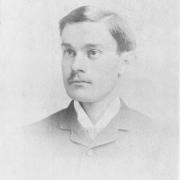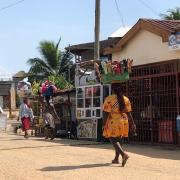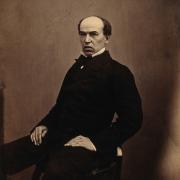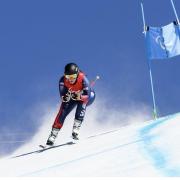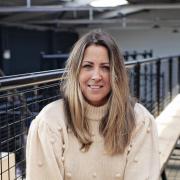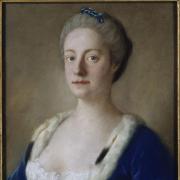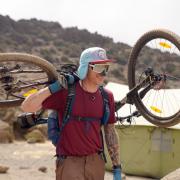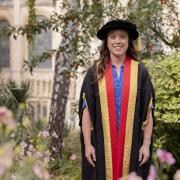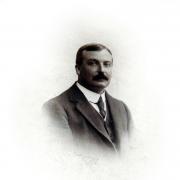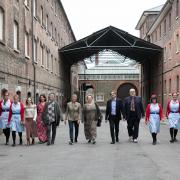Wye artist and former academic David Hayward uses hot-air guns and a blowtorch to create his dramatic seascapes.
At the now-defunct Wye Agricultural College, after a long career in higher education, David Hayward now spends his days surrounded by paint, encaustic, beeswax and a whole range of implements for heating his material up.
He uses hot-air guns, as often a work will need reheating, and there is also a little blow torch for making crème brûlée, which he applies to the paint, plus an electric hot plate that melts the wax and makes it flow.
Encaustic is rarely used and quite a dangerous material to work with, but David appears entirely unfazed as he explains his choice of medium: “Encaustic is oil paint dissolved in heated beeswax, an ancient medium used by the Egyptians and the Romans. The process is quite physical and tolerates trial, error and change - which suits my temperament.”
At present David is working on a series of seashore-inspired works and layers of paint are being built up. Beneath these on the floor are peelings of paint, as the process involves much scraping off and repainting. Eat your heart out Gerhard Richter (the German visual artist)!
This process also allows David to explore, in his own words, “a wide range of expressive surface qualities” - hence the peelings. He adds: “Layers of paint are excavated and then they are re-embedded, often being moved between paintings to create marks and motifs that prompt our capacity to seek connections with prior experiences. Certain marks, combinations and shapes will tend to draw up a memory.”
The process is almost archaeological, a term I find easier than the description ‘forensic’ that David prefers.
There are two very different sets of works scattered around the walls and on the floor. On a trestle there are some delicate watercolour and ink landscapes of the surrounding Kentish Downland, which David loves.
Then there are the large abstracts on boards, where the viewer always tends to see a form, a leaf, a flower, what Kazimir Malevich has called a ‘habit of mind.’ David’s current work, depicting rocks, is what he calls his North Shore works, but also the Second Day series, a reference to the creation in Genesis.
He admits this series is the least abstract, more elemental: “I am trying to make a link between the small watercolour and ink works on the heavy paper and the encaustic boards.”
I ask David to define the genre he paints in and he tells me: “My work is predominantly abstract but there are strong underlying connections to landscape, its geology and climate.”
He has just come back from hiking in the Appalachians, where he made good use of his favourite moleskin notebooks.
“I was particularly struck by the layering and markings on the bark of silver birch trees. I am sure that will make an appearance in new work,” he says.
However, it is the geology of mud, sand, rock, flotsam and jetsam, the weather, the mood and the sheer transience of shorelines that attracts him and one of the most frequent factors in his work is coastlines.
There is a great palette of colour in most of the works, so it surprises me that David says he would choose grey if he had to be restricted to just one colour.
“Greys can be wonderfully, if subtly, colourful and allow an almost complete tonal range, from almost black to almost white.”
When it comes to size, while currently restricted by practical matters such as his arm length and the size of his estate car, David’s recent trip to New York showed him works of an ambitious scale. “I would be happy to work large, but scale brings into play a whole new set of factors – both technical and economic – perhaps when I can afford studio assistants!” he admits.
Currently working on wooden panels up to three to four metres, a work may take from a day to many weeks or even months.
“Each painting seems to dictate its own timescale that can’t be second guessed. Sometimes a painting just doesn’t want to be painted,” he says.
David has some very wise advice to offer a young artist. “I would say that creativity is not dependent on ‘talent’ (other than the talent to persevere) nor technical skill (such skills can be developed through perseverance and necessity).
“The real test is being inquisitive and excited by the visual, cultural or the emotional characteristics of the world around us and exploring that excitement by the intelligent use of material and processes.”
David could also add his own ambition for himself: to just keep on painting. As he points out, painting, has been “undeniably important in the development of civilisations across the entire globe.”
Get in touch:
David Hayward’s studio is at The Wyseplan Building, Occupation Road, Wye TN25 5EN and he welcomes studio visits by appointment. Contact him via the website: www.david-hayward.com
David has had paintings in the Royal Academy and you can see his work at Keynes College, University of Kent at Canterbury, University Road, Canterbury CT2 7NP, 01227 823622.
The work is on show from 19 November to 10 January 2016.
w






